Melbourne couple devotes years and passion in creating their Garden of Eden
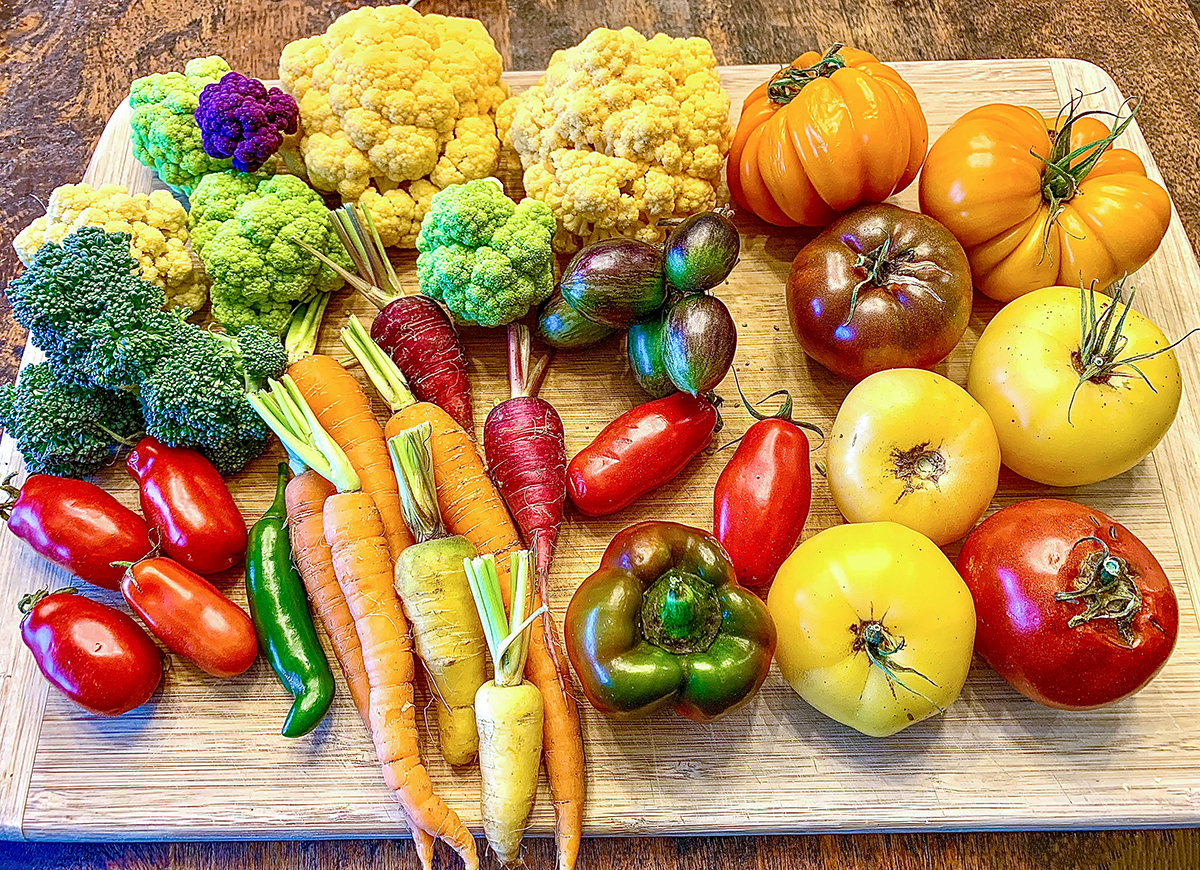
Bruce and Gina Ragan’s Garden of Eden is an alternative to purchasing expensive organic fruits and veggies. GINA RAGAN PHOTOS
For nearly 35 years, Bruce and Gina Ragan have enjoyed careers that engage their extreme creativity.
Bruce, an iconic East Coast surfboard builder, and Gina, a talented landscape painter and photographer, the Melbourne couple share a passion for everything nature, healthy eating and self-sustainability.
A peek at their quarter-acre backyard, where more than a hundred different varieties of fruits and vegetables grow, along with trees, exquisite flowers and roses, dozens of herbs, five varieties of exotic dragon fruits and three species of apple trees [a rarity in Florida], confirms that their combined creativity has been key in their efforts to grow their special Garden of Eden.
“Our garden of 25 years has become my full-time job, as it requires hours of researching everything from climate zones to fertilizers, composting, soil and seed choices, constructing and maintaining wood and metal blocks, locating affordable and necessary nursery pots, and other amendments,” Gina Ragan explained.
“The list goes on, with routine planting, watering and harvesting processes and, of course, preparation to protect the garden in the event of extreme hot or cold weather that can come our way.”
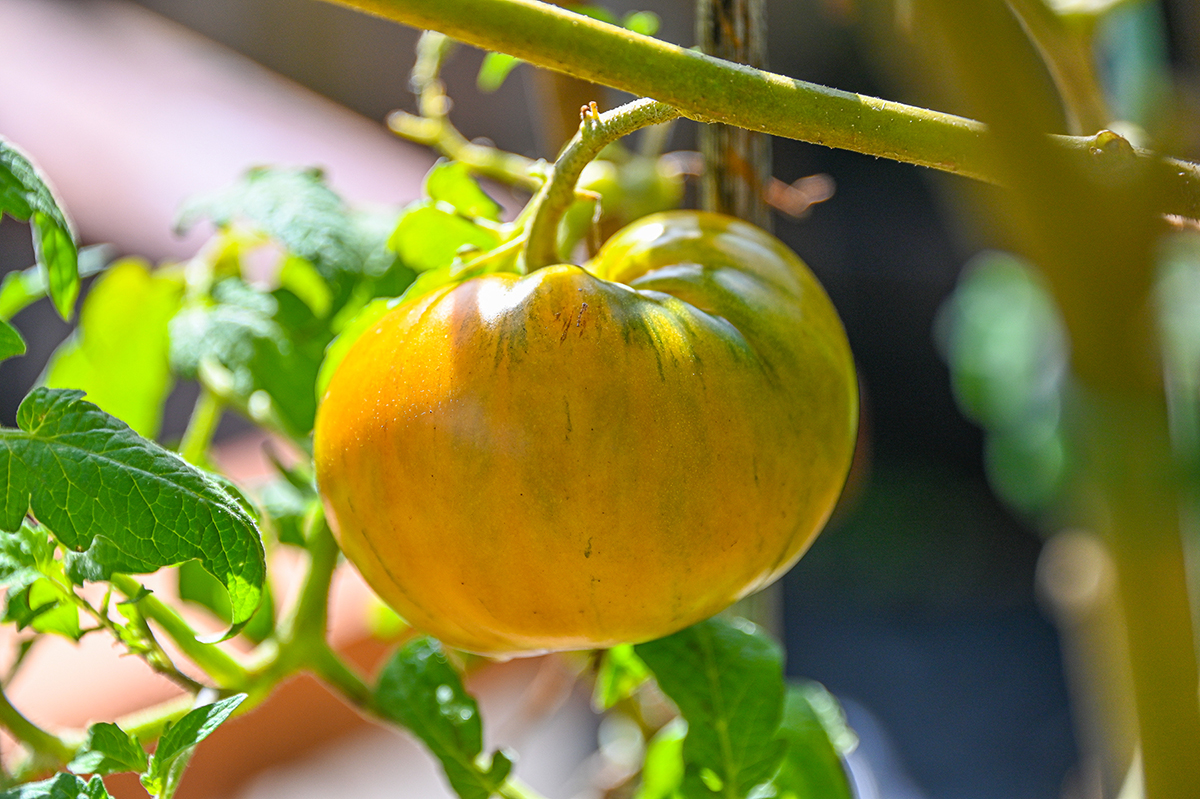
A yellow tomato is one of 15 varieties grown in the couple’s garden.
HOMEGROWN IS BEST
Prior to growing their own fruits and veggies, the couple always purchased organically grown produce, something she said is typically pricey and often hard to come by.
“Gardening in the Central Florida area can be a year-round opportunity, but there are definitely specific things to consider,” she said. “While spring and fall are best seasons, every plant is different.”
“I try to let the soil rest [during the warmer summer months].”
Because they live in the 9B zone, it is sometimes tricky to grow some plants.
“Those plants suited for a more southern climate in South Florida may not always be ideal to grow here in Brevard, so the process demands some patience, and often, trial and error,” she explained.
Ragan also prefers homegrown fruits and vegetables especially with the current pandemic situation.
“I always know where they come from, how they were grown and that they are available and plentiful if I am doing my job correctly,” she said. “In our current environment with supply chain shortages etc., this can be very comforting. Efficient gardening practices can be a great return on the investment for many reasons. Monetarily, depending on the time of the year, our monthly harvest saves us around $40-$50, versus what we would be spending if we purchased the same produce from a grocer or market.”
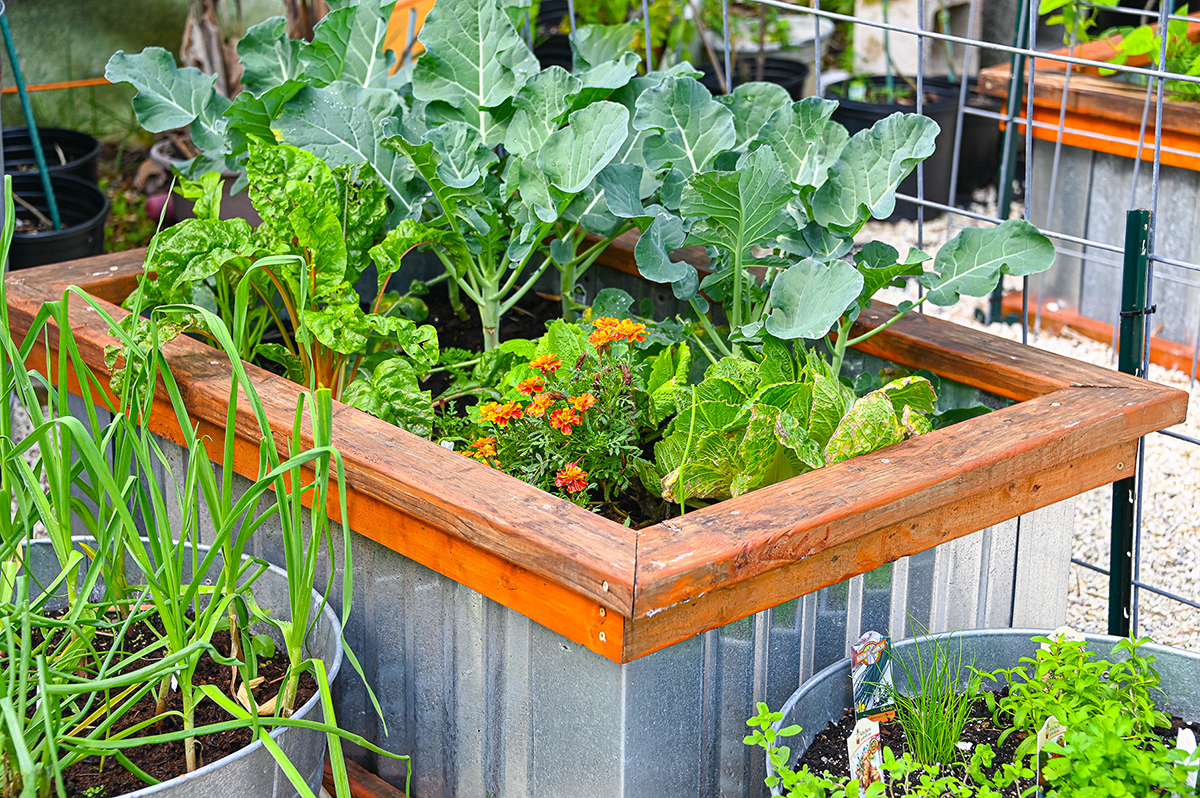
Above ground wood and metal planter boxes provide benefits by saving space, easy watering and keeping the soil fertile and intact.
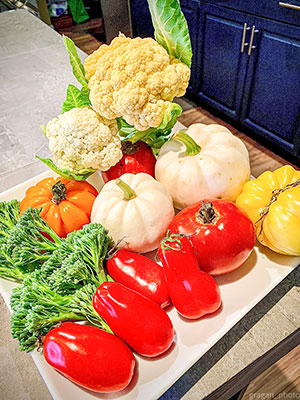
A sampling of a typical harvest, these veggies are part of the bountiful backyard that has become the Ragans’ creative outlet for more than 25 years.
LOTS OF WATERING
With 15 different varieties of tomato plants to tend to, citrus trees including three lime, three lemon and two different orange trees, two pear trees, two peach trees, a pomegranate, fig, plum tree, avocado, macadamia, guava, mulberry, and several banana trees, plus lettuce, carrots, peppers, cucumbers, squash, and more, just the fertilizing and watering alone is obviously a huge task.
And their fruit collection doesn’t end there.
“Our seven blueberry bushes give us an abundance of sweetness and flavor that we often share with friends and neighbors,” she said. “We also enjoy raspberries and blackberries when in season, along with strawberries, grapes, pineapples, lychee fruit, apples, cherries and papaya.”
Ragan explained that her garden and its design, which wraps around the pool and spans to the east side of the property, has always been based on what she refers to as ease of use.
“I try to think in terms of, can I get a wheelbarrow through the paths, and are they wide enough?”
Other factors include the use of direct sunlight and shaded areas, which can determine decisions as to where to locate specific plants to best fulfill their needs.
“We have a koi pond near the pool that is also a part of our backyard landscape and enjoy entertaining and barbecues during the spring and summer months,” she said. “The garden has become an extension of this additional outdoor living space.”
Ragan also said that most of their trees are in pots because being planted too close to the house could damage its foundation.
“The use of planters and pots also enable better use of available sunlight, as well as the efficient and ease of use of our irrigation source,” she added.
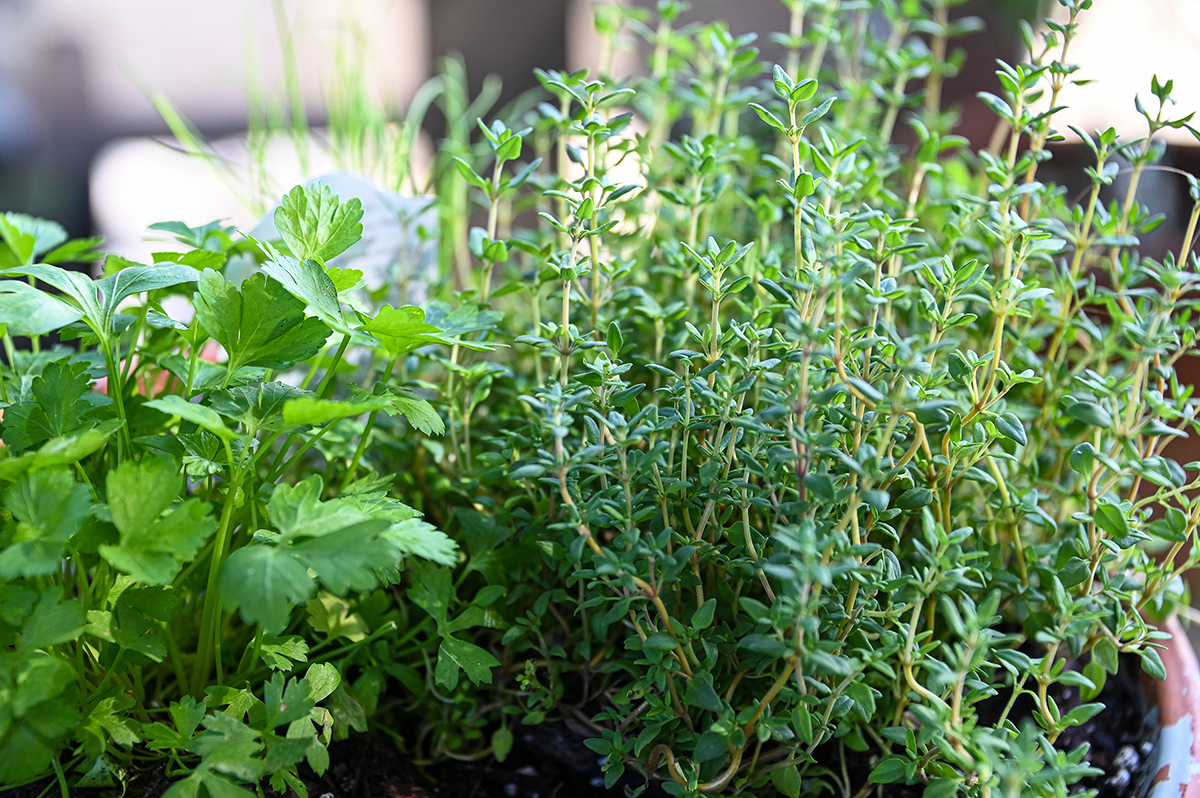
Parsley, cilantro and rosemary are just a few herb varieties that are easy to grow and invaluable for multiple seasoning uses.
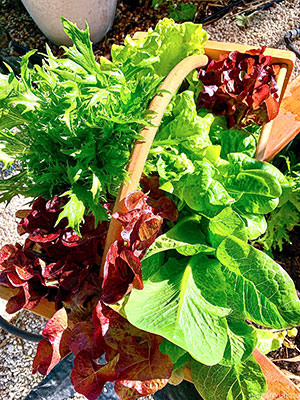
Leafy and colorful red and green lettuce and arugula make for excellent salad options that can be combined with other garden veggies.
BEGINNERS ADVICE
The best advice she has for new gardeners is to set limits.
“My recommendation is for newbie gardeners to start small,” she said. “If space is limited, my advice is to purchase a few pots and plant herbs to start. They can be found at local nurseries or garden centers, sometimes even at yard sales. There is a lot of information online, and YouTube is a great resource. Many local libraries also have dozens of books and magazines that offer an abundance of knowledge.”
She also suggests being well informed on what it will cost to start a garden.
“Research is always a gardener’s best friend,” she advised. “The initial start-up costs are relatively inexpensive, and once you make the investment, the ongoing expenditures will depend on choices of plants, recycling and reuse of materials, seeds, etc.
“Nursery pots, buckets or even grow bags can be a great choice to start. Once you have seeds that come from most flowering veggies or flowers, they can be dried and stored for use when planting during the next season,” she added.
The choice of fertilizers varies but Ragan likes to use organic fertilizers.
“Dr. Earth and Espoma are my go-to brands and can be combined with fish emulsion,” she said.
“Worm castings and mushroom compost are my amendments. As a rule, I try to purchase my fertilizers, compost and fish emulsion on an annual basis.”
It is Bruce Ragan’s job when it comes to the look of the garden and providing support for the plants’ vines.
“Bruce has been my best asset when it comes to help with the design and construction of our wood and metal block above ground plant boxes,” Ragan said. “We have added several cattle panels around the bean, cucumber, pea and melon plants which are designed to allow the vines to crawl up on them.”
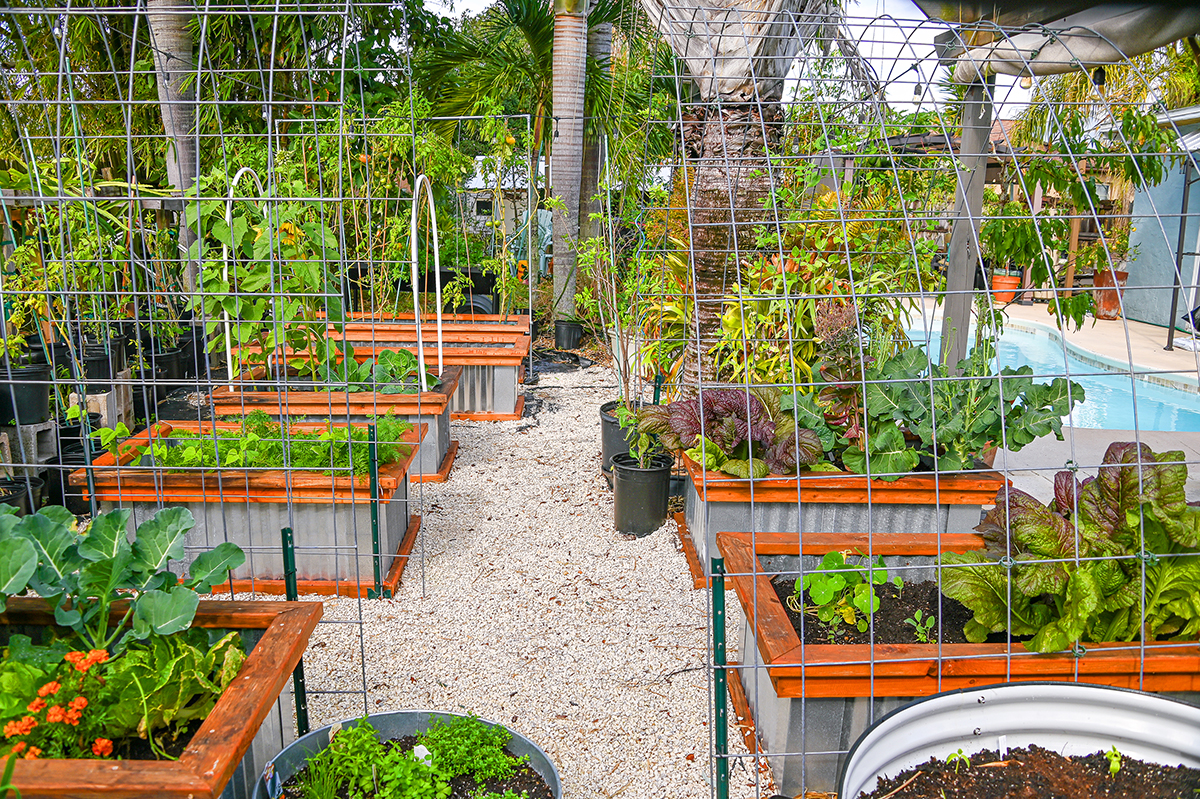
The couple’s backyard design provides ease of access, as well as sunlight and shade use to best fulfill the needs of specific plants.
COLORFUL AND TASTY
One thing she likes to do when deciding on what to plant is to mix edible plants with colorful flowers.
“My goal has always been to grow plants that are edible or can be used for seasonings, but I enjoy adding flowers to the garden to add a bit of color and beautification to the mix,” she explained.
“Parsley, rosemary, basil and oregano are staples that can be grown year-round. I always find our fresh lime and lemons to be invaluable for juice sources to marinate fish, seafood and other cooking, and baking uses. I dry many of my herbs and some of the fruits. A lot of the fruits can also be frozen and are great for making sorbet and smoothies.”
She said she especially enjoys making different sauces and veggie snacks, fruit pies, pastries and breads from her many garden delicacies.
“Though I have yet to tackle canning, I hope this will be something I can do soon,” she added.
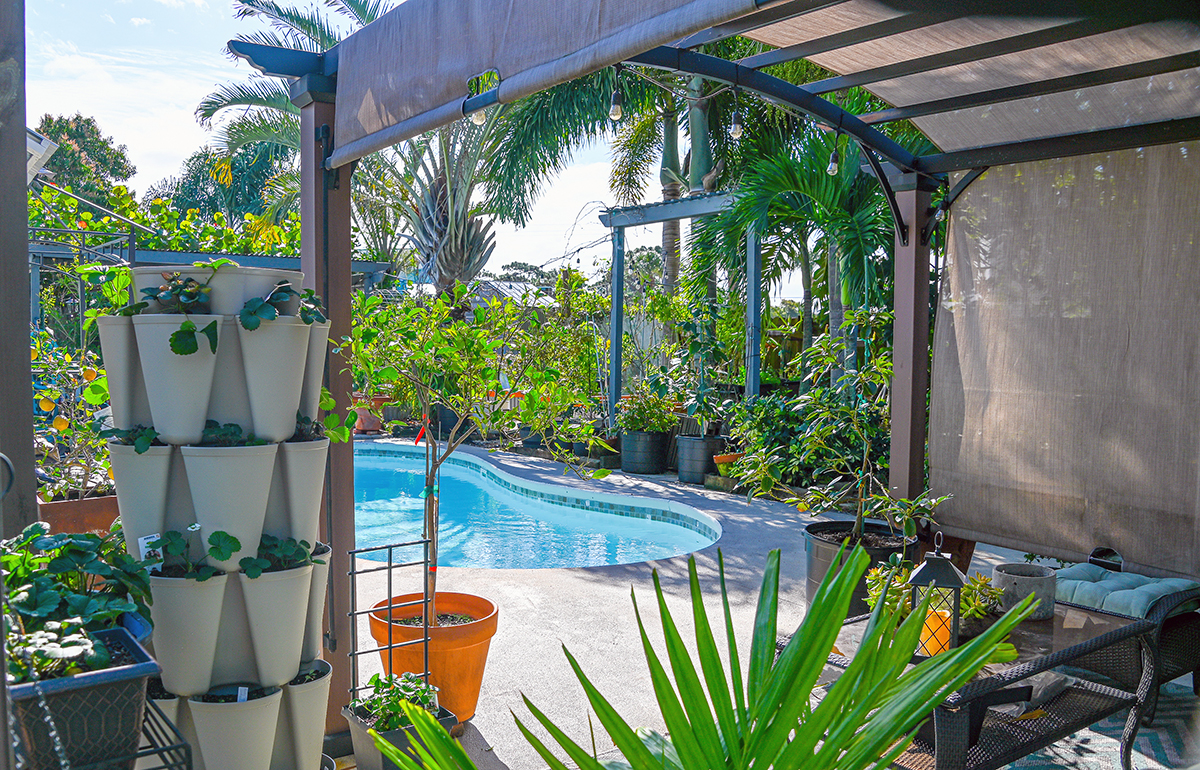
Filled with everything from citrus trees to blueberry bushes to vegetables and flowers, the garden is designed to wrap around the backyard pool.
Variety has been called the spice of life and she is always looking for new experiences.
“I am always up for planting new things, and many times it can be a process of trial and error,” she said. One of my favorite trees in our garden is our olive tree. It may not be a tree that many find typical for a Florida garden, but experimentation has always been a part of gardening that I love, even if sometimes a challenge.
“Whether creating art, surfboards or gardening, the process can be similar. It’s about doing something you love, and in my case is my lifeblood,” she said.
“The bonus with gardening is getting to eat fresh and enjoy the end results — the tasty fruits and veggies, and beauty of my flowers and natural surroundings each and every day.”

Sue DeWerff Panzarino
Sue is an avid surfer, shark attack survivor and storyteller who loves to write about the wonderful people and great organizations on the Space Coast.




